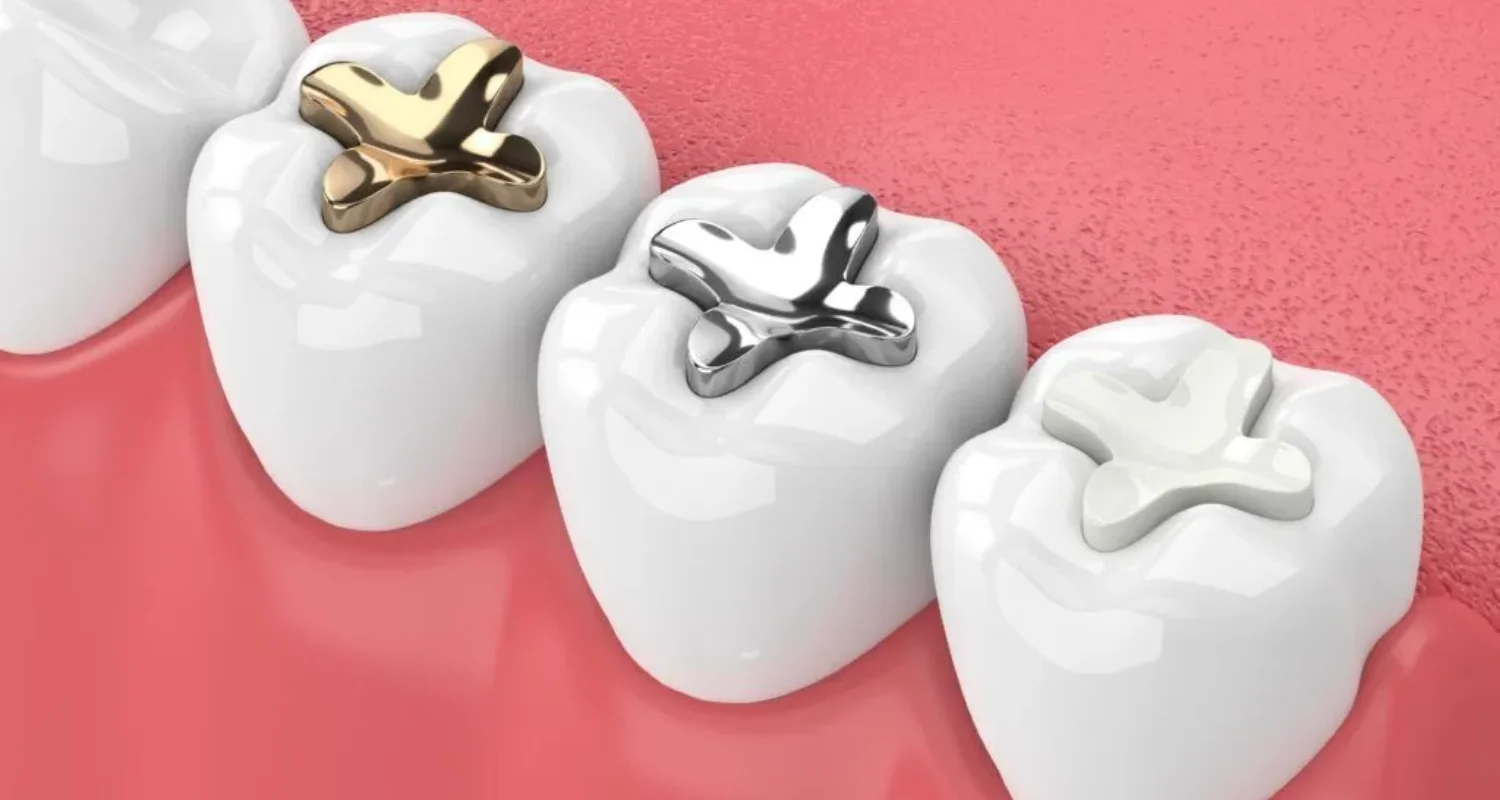Last Updated on: 16th December 2025, 10:55 am
To relieve tooth pain after a filling, use natural remedies like saltwater rinses or clove oil, and take OTC pain relievers such as ibuprofen. If the pain persists beyond a week, consult a dentist to rule out complications like nerve irritation or high filling placement.
Are you having some problems with tooth pain after filling?
Our teeth are like tiny protectors –built to handle a lot. On the outside, they have a strong shield made of enamel and dentin, but on the inside, there is a softer, more delicate part called the pulp. It is very sensitive and reacts to everything, from the chill of ice cream to the heat of fresh soup. The trouble begins when cavities start to break down the protective shield. This happens because bacteria feed on the sugars we eat, producing acids that gradually weaken teeth. If the cavity gets too deep, it can reach the pulp, leading to pain, infections, and even tooth loss.
Thankfully, fillings are like armor that helps restore the tooth’s strength; however, occasionally, a filling can cause sensitivity or mild discomfort. We’re here to help you understand what might be happening. In this article, we’ll explain the most common reasons for pain after getting a filling, how to ease it, and when it’s time to consult your dentist.
What Causes Tooth Pain After a Filling?
Tooth pain after a filling is common and typically temporary. Causes include:
- Nerve irritation from deep cavities close to the pulp
- High filling that affects your bite and causes pressure
- Material sensitivity, particularly with composite resin
- Post-procedure inflammation, especially after multiple fillings
Signs that the pain may signal a problem:
- Sharp, persistent pain
- Swelling or bleeding
- Discomfort while chewing
- Worsening pain over time
What are Dental Fillings?
Imagine your tooth as a part of your home’s foundation and a cavity as a small crack or damage in it. If left untreated, that crack could expand, compromising the stability of the entire structure. Similarly, dental fillings are essential for repairing damage caused by decay or fractures in the teeth.
Fillings restore the tooth’s shape, protecting it from further harm and ensuring it functions properly. There are different types of fillings, each with unique properties to suit different needs. The most common ones include:
- Composite resin: a favorite in modern dentistry due to its natural appearance, versatility, and wide range of colors. It creates durable restorations that blend seamlessly with your teeth, though the placement process requires careful attention.
- Glass ionomer: a material made from glass particles and polyacrylic acid. It releases fluoride to help stop cavities, making it especially useful in moist environments where other materials may not work well.
- Amalgam: a combination of metals, like silver and mercury, known for its strength and affordability. It’s great for repairing molars, but its metallic look and concerns about mercury have led to a decline in its use.
What is the Process of Getting a Filling?
The process of placing a composite resin filling, one of the most commonly used materials today, involves several steps to ensure a durable and functional restoration. Here’s a simple breakdown:
1. Removing decay: The dentist begins by thoroughly removing all decay and damaged tissue from the affected area. This ensures the tooth is clean, solid, and ready for the next stage.
2. Preparing the cavity: The cleaned cavity is treated with special agents that enhance the resin’s ability to bond securely to the affected tooth. This step is essential for creating a long-lasting restoration.
3. Protecting the nerve (If Needed): If the decay is deep and close to the nerve, the dentist may apply a protective layer known as a pulp liner. This safeguards the nerve from direct contact with the resin and helps minimize sensitivity or discomfort.
4. Applying the resin: The composite resin is placed into the cavity as a soft, pliable material. The dentist carefully shapes it to match the tooth’s natural contours. Once the desired shape is achieved, the resin is hardened using a special curing light.
5. Smoothing and polishing: After the resin has been set, the filling is polished to eliminate rough edges and ensure it aligns perfectly with your bite. This final touch leaves the tooth looking natural and feeling smooth.
The goal of this process is to restore the tooth’s structure and function while preventing future decay or damage. A properly placed filling allows the tooth to work and look as good as new! However, sometimes people can suffer from tooth pain after filling.
Is it Normal to Experience Tooth Pain After Filling?
Yes, it is completely normal to experience some sensitivity or tooth pain after filling, especially if the cavity has affected a large portion of the tooth. This occurs because the tooth needs time to heal and adjust, similar to how the body recovers after an injury. While the nerve heals, it’s important to take care of your tooth by avoiding very cold, hot, acidic, or hard foods, plus paying attention to any signals your body may send.
Warning Signs After a Dental Filling
While some mild sensitivity is normal, there are certain signs that the tooth pain after filling may indicate a problem:
- Sharp pain: If you experience sharp or intense pain that doesn’t subside after a few days, it could indicate an issue, such as an improperly placed filling or a problem with the tooth.
- Swelling or bleeding: If there is swelling in the gum area or persistent bleeding around the filled tooth, this could be a sign of infection or inflammation.
- Discomfort while chewing: a feeling of pressure or that there’s a “stone” in the tooth.
- Persistent or worsening pain: If the pain continues to get worse or lasts for weeks, it may indicate complications such as nerve damage or an underlying issue with the filling.
If you notice any of these symptoms, don’t hesitate to contact your dentist. Addressing these signs early can prevent complications and ensure proper healing.
How Long Does Tooth Pain Last After a Dental Filling?
After getting a dental filling, some discomfort or sensitivity is common, but the duration and intensity will vary. Here’s what you can typically expect:
Mild pain or sensitivity: For most people, the tooth pain after filling lasts for a few days to a week after the procedure. This is often due to the tooth adjusting to the filling, particularly if the material used is composite or amalgam. Sensitivity to hot, cold, or pressure can also occur during this time.
Factors that affect pain duration: Several factors influence how long pain may last, including:
- Depth of the cavity: A deeper cavity, especially one close to the nerve, may result in more significant tooth pain after filling, as the tooth takes longer to heal. This usually happens in cases such as cavities under crowns.
- Material used: Some materials, like composite resin, may cause more sensitivity in the early days compared to others, like amalgam.
- Individual sensitivity: Each person’s pain tolerance and sensitivity to dental procedures can vary, so some may experience discomfort for a longer period.
When the cavity is deep or several fillings are done during a single visit, the discomfort may last longer. A deep filling is closer to the nerve, which can cause increased irritation or sensitivity. Additionally, undergoing multiple treatments in one session puts more strain on the tooth and the surrounding tissues, potentially delaying the healing process. It’s important to allow your tooth time to recover, but if the pain continues for more than a few weeks or becomes worse, it’s advisable to consult your dentist.
How to Relieve Tooth Pain After Filling?
Natural remedies
1. Saltwater rinse: Gargling with warm salt water helps reduce inflammation and cleanse the area of bacteria. Perform 1 or 2 times a day, after proper oral hygiene.
2. Clove oil: Clove oil numbs the pain and soothes irritated nerves due to its natural anesthetic properties. Apply a drop directly to the tooth with a cotton swab to reduce sensitivity.
3. Cold compress: A cold compress reduces swelling and numbs the pain by constricting blood vessels. Apply to the outside of the mouth to reduce internal tooth inflammation. Use for less than 5 minutes every 30 minutes to avoid irritating the skin in the application area.
4. Garlic paste: Garlic toothpaste has antibacterial and anti-inflammatory properties, helping to reduce minor inflammation.
5. Tea bags: Apply as a warm compress to the affected area. The tea has anti-inflammatory properties that can provide temporary relief from discomfort after a dental filling.
Over-the-counter medicines
- Pain relievers (e.g., Ibuprofen, Acetaminophen): These medications help reduce pain and inflammation, providing relief after a dental filling.
- Desensitizing toothpaste: Specially formulated to block nerve signals, desensitizing toothpaste can help manage tooth sensitivity following a filling.
- Topical gels or anesthetics: These products are applied directly to sensitive areas and offer temporary pain relief by numbing the affected region.
What to do if Tooth Pain After Filling Doesn’t go Away
When Should You See a Dentist?
You should consult a dentist if the pain persists for more than a week, as it may suggest a more serious issue. If the pain becomes sharp or throbbing and worsens over time, it could indicate complications such as a tooth infection or nerve irritation. Additionally, if you notice signs of infection like swelling, fever, or pus near the treated tooth, it’s essential to seek immediate dental care to prevent further complications.
Possible dental solutions
If the pain persists or worsens after several days, it may no longer be the normal sensitivity following a filling, and additional treatments may be needed. The choice of treatment will depend on the cause of the pain. Here are some common options:
- Adjusting a high filling: If the filling is too high, it can affect your bite and cause discomfort. A dentist will adjust it to ensure a proper fit.
- Treating underlying issues: A cracked tooth or nerve damage could be causing ongoing pain. Addressing these issues may require further treatment.
- Pulp protection: In some cases, a material is placed near the nerve of the tooth to reduce inflammation after the decay has been removed. This treatment protects the nerve and promotes healing, helping to prevent ongoing discomfort.
- Pulpotomy: It involves removing the damaged part of the nerve while preserving the healthy portion. A bioceramic material is placed to promote healing and reduce inflammation. This treatment is effective for young patients and can avoid the need for a root canal, though it may be more expensive.
- Root canal: In more severe cases, a root canal may be necessary to remove infected or damaged tissue inside the tooth and restore its health.
Remember, if you experience prolonged tooth pain after filling, it’s best to consult your dentist for an accurate diagnosis and timely treatment.
How to Prevent Tooth Pain After Fillings
In many cases, tooth pain after filling is hard to prevent. It depends on factors outside of the patient’s control, such as the severity of the decay, the condition of any previous restorations, or the complexity of the procedure. Therefore, the best way to avoid discomfort is to prevent the need for a filling altogether. We suggest the following:
- Practice good oral hygiene: Brush after each meal, floss daily, and use the appropriate toothbrushes and products for your needs.
- Visit your dentist regularly: Routine check-ups help catch problems early, preventing cavities from worsening.
- Maintain a healthy diet: A balanced diet low in refined sugars helps protect against cavities and keeps your teeth strong.
Finally, always listen to your body. If after the procedure you feel that the filling isn’t properly adjusted or notice persistent discomfort, don’t hesitate to contact your dentist as soon as possible. Acting promptly can prevent complications and ensure a comfortable, trouble-free recovery.
Care after a dental filling
- Avoid eating for the first hour after the procedure.
- Maintain careful oral hygiene with a soft or medium-bristled toothbrush.
- Use a night guard if you grind your teeth.
- Follow the dentist’s instructions and attend scheduled check-ups.
Foods to avoid
- Sticky foods: Foods like caramels and chewing gum can dislodge the filling, leading to damage or discomfort.
- Hard or crunchy foods: These can put stress on the tooth, potentially causing the filling to crack or become loose. Example: Nuts, raw vegetables
- Very hot or cold foods and drinks: Extreme temperatures can worsen sensitivity, causing discomfort around the filling.
- Sugary foods: Foods such as candies and sodas can irritate the tooth and contribute to further decay, especially around the filling.
- Acidic foods: Acidic foods can irritate the area around the filling, causing pain or discomfort.
Conclusion
After a dental filling, mild discomfort is normal; it usually fades within a few days to a week. However, if tooth pain after filling lasts longer or worsens, it may be a sign of an underlying issue, such as a filling that is too high or an infection. Recognizing when the pain becomes concerning, such as sharp discomfort or swelling, is essential for timely treatment. Seeking professional care early can help prevent further complications and ensure the success of the dental filling.
To reduce the risk of tooth pain after a filling, practicing good oral hygiene, avoiding certain foods, and attending regular dental check-ups are crucial. These steps can help maintain the filling’s integrity and your overall dental health. If you experience persistent discomfort, don’t hesitate to visit your dentist for an evaluation. Timely intervention can address problems like nerve irritation or filling misalignment, ensuring that your dental work continues to support your teeth effectively.
Frequently Asked Questions
Is it normal to experience pain after dental filling?
Yes, mild discomfort or sensitivity is common after a dental filling. This is usually due to the irritation of the tooth or surrounding tissues during the procedure. It typically fades within a few days to a week.
What should I do if the pain doesn’t go away?
If the pain lasts longer than a week or intensifies, it is important to see your dentist. Persistent or worsening pain could indicate a problem like an infection, nerve damage, or a filling that needs adjustment.
What are the risks of having a toothache after a filling?
Toothache after a filling is usually temporary and resolves within a few days; in some cases, it may indicate potential risks or complications as nerve irritation from a deep cavity, cracks or decay beneath the filling, or, in rare cases, an allergic reaction to the material.
How can I relieve tooth pain after filling?
You can try natural remedies like saltwater rinses, cold compresses, or clove oil to alleviate discomfort. Over-the-counter pain relievers such as ibuprofen or acetaminophen also help to reduce pain and inflammation.
Can I prevent tooth pain after a filling?
While it’s difficult to prevent all discomfort, maintaining good oral hygiene, following post-treatment instructions, and avoiding certain foods help minimize the risk of complications. Regular dental check-ups will catch any issues early.
How do I stop my tooth from hurting after a filling?
To stop tooth pain after a filling, rinse with warm salt water, use clove oil or ibuprofen, and avoid hard or hot foods. If pain lasts over a week, see your dentist.
Share
References
1. Berry, J. (2024, November 25). Why does my tooth still hurt after a filling? https://www.medicalnewstoday.com/articles/324267
2. Cleveland Clinic Collaborators. (2024a, May 16). Dental fillings. Cleveland Clinic. https://my.clevelandclinic.org/health/treatments/17002-dental-fillings
3. Higuera, V. (2024, January 30). How to Handle Sensitive Teeth After a Filling. Healthline. https://www.healthline.com/health/tooth-sensitivity-after-filling
4. Mekhdieva, E., Del Fabbro, M., Alovisi, M., Comba, A., Scotti, N., Tumedei, M., Carossa, M., Berutti, E., & Pasqualini, D. (2021, september 29). Postoperative Pain following Root Canal Filling with Bioceramic vs. Traditional Filling Techniques: A Systematic Review and Meta-Analysis of Randomized Controlled Trials. Journal Of Clinical Medicine, 10(19), 4509. https://doi.org/10.3390/jcm10194509
5. WebMD. (2024, october 14). Dental Health and Tooth Fillings. WebMD. https://www.webmd.com/oral-health/dental-health-fillings
-
Dr. Yeidy Carolina Mesa [Author]
DDS Yeidy Carolina Mesa Passionate Dentist | Advocate for Accessible Oral Health Education Graduating from Universidad CES in 2022, I am a dedicated general dentist with a lifelong passion for helping others and making a meaningful impact in the world. My journey into dentistry began at the age of 7, inspired by my own experience with braces and overcoming a fear of the dentist. This personal journey shaped my mission to help patients conquer their own dental anxieties and embrace a healthier,...
View all posts




















